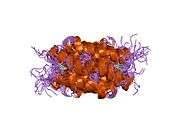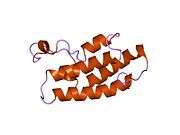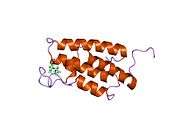PCAF
| View/Edit Human | View/Edit Mouse |
P300/CBP-associated factor (PCAF), also known as K(lysine) acetyltransferase 2B (KAT2B), is a human gene and transcriptional coactivator associated with p53.
Structure
Several domains of PCAF can act independently or in unison to enable its functions. PCAF has separate acetyltransferase and E3 ubiquitin ligase domains as well as a bromodomain for interaction with other proteins. PCAF also possesses sites for its own acetylation and ubiquitination.[5]
Function
CBP and p300 are large nuclear proteins that bind to many sequence-specific factors involved in cell growth and/or differentiation, including c-jun and the adenoviral oncoprotein E1A. The protein encoded by the PCAF gene associates with p300/CBP. It has in vitro and in vivo binding activity with CBP and p300, and competes with E1A for binding sites in p300/CBP. It has histone acetyl transferase activity with core histones and nucleosome core particles, indicating that this protein plays a direct role in transcriptional regulation.[6]
Regulation
The acetyltransferase activity and cellular location of PCAF are regulated through acetylation of PCAF itself. PCAF may be autoacetylated (acetylated by itself) or by p300. Acetylation leads to migration to the nucleus and enhances its acetyltransferase activity.[7] PCAF interacts with and is deacetylated by HDAC3, leading to a reduction in PCAF acetyltransferase activity and cytoplasmic localisation.[8]
Protein interactions
PCAF forms complexes with numerous proteins that guide its activity. For example PCAF is recruited by ATF[9] to acetylate histones and promote transcription of ATF4 target genes.
Targets
There are various protein targets of PCAF's acetyltransferase activity including transcription factors such as Fli1,[10] p53[11] and numerous histone residues. Hdm2, itself a ubiquitin ligase that targets p53, has also been demonstrated to be a target of the ubiquitin-ligase activity of PCAF.[5]
Interactions
PCAF has been shown to interact with:
See also
References
- ↑ "Diseases that are genetically associated with KAT2B view/edit references on wikidata".
- ↑ "Drugs that physically interact with Histone acetyltransferase KAT2B view/edit references on wikidata".
- ↑ "Human PubMed Reference:".
- ↑ "Mouse PubMed Reference:".
- 1 2 Linares LK, Kiernan R, Triboulet R, Chable-Bessia C, Latreille D, Cuvier O, Lacroix M, Le Cam L, Coux O, Benkirane M (March 2007). "Intrinsic ubiquitination activity of PCAF controls the stability of the oncoprotein Hdm2". Nat. Cell Biol. 9 (3): 331–8. doi:10.1038/ncb1545. PMID 17293853.
- ↑ "Entrez Gene: PCAF p300/CBP-associated factor".
- ↑ Santos-Rosa H, Valls E, Kouzarides T, Martínez-Balbás M (August 2003). "Mechanisms of P/CAF auto-acetylation". Nucleic Acids Res. 31 (15): 4285–92. doi:10.1093/nar/gkg655. PMC 169960
 . PMID 12888487.
. PMID 12888487. - ↑ Grégoire S, Xiao L, Nie J, Zhang X, Xu M, Li J, Wong J, Seto E, Yang XJ (February 2007). "Histone deacetylase 3 interacts with and deacetylates myocyte enhancer factor 2". Mol. Cell. Biol. 27 (4): 1280–95. doi:10.1128/MCB.00882-06. PMC 1800729
 . PMID 17158926.
. PMID 17158926. - ↑ Chérasse Y, Maurin AC, Chaveroux C, Jousse C, Carraro V, Parry L, Deval C, Chambon C, Fafournoux P, Bruhat A (2007). "The p300/CBP-associated factor (PCAF) is a cofactor of ATF4 for amino acid-regulated transcription of CHOP". Nucleic Acids Res. 35 (17): 5954–65. doi:10.1093/nar/gkm642. PMC 2034469
 . PMID 17726049.
. PMID 17726049. - ↑ Asano Y, Czuwara J, Trojanowska M (November 2007). "Transforming growth factor-beta regulates DNA binding activity of transcription factor Fli1 by p300/CREB-binding protein-associated factor-dependent acetylation". J. Biol. Chem. 282 (48): 34672–83. doi:10.1074/jbc.M703907200. PMID 17884818.
- ↑ Liu L, Scolnick DM, Trievel RC, Zhang HB, Marmorstein R, Halazonetis TD, Berger SL (February 1999). "p53 sites acetylated in vitro by PCAF and p300 are acetylated in vivo in response to DNA damage". Mol. Cell. Biol. 19 (2): 1202–9. PMC 116049
 . PMID 9891054.
. PMID 9891054. - ↑ Lin HR, Ting NS, Qin J, Lee WH (Sep 2003). "M phase-specific phosphorylation of BRCA2 by Polo-like kinase 1 correlates with the dissociation of the BRCA2-P/CAF complex". J. Biol. Chem. 278 (38): 35979–87. doi:10.1074/jbc.M210659200. PMID 12815053.
- ↑ Fuks F, Milner J, Kouzarides T (Nov 1998). "BRCA2 associates with acetyltransferase activity when bound to P/CAF". Oncogene. 17 (19): 2531–4. doi:10.1038/sj.onc.1202475. PMID 9824164.
- ↑ Ge X, Jin Q, Zhang F, Yan T, Zhai Q (Jan 2009). "PCAF acetylates {beta}-catenin and improves its stability". Mol. Biol. Cell. 20 (1): 419–27. doi:10.1091/mbc.E08-08-0792. PMC 2613091
 . PMID 18987336.
. PMID 18987336. - ↑ Tini M, Benecke A, Um SJ, Torchia J, Evans RM, Chambon P (Feb 2002). "Association of CBP/p300 acetylase and thymine DNA glycosylase links DNA repair and transcription". Mol. Cell. 9 (2): 265–77. doi:10.1016/S1097-2765(02)00453-7. PMID 11864601.
- 1 2 Cho H, Orphanides G, Sun X, Yang XJ, Ogryzko V, Lees E, Nakatani Y, Reinberg D (Sep 1998). "A human RNA polymerase II complex containing factors that modify chromatin structure". Mol. Cell. Biol. 18 (9): 5355–63. PMC 109120
 . PMID 9710619.
. PMID 9710619. - ↑ Chakraborty S, Senyuk V, Sitailo S, Chi Y, Nucifora G (Nov 2001). "Interaction of EVI1 with cAMP-responsive element-binding protein-binding protein (CBP) and p300/CBP-associated factor (P/CAF) results in reversible acetylation of EVI1 and in co-localization in nuclear speckles". J. Biol. Chem. 276 (48): 44936–43. doi:10.1074/jbc.M106733200. PMID 11568182.
- ↑ Soutoglou E, Papafotiou G, Katrakili N, Talianidis I (Apr 2000). "Transcriptional activation by hepatocyte nuclear factor-1 requires synergism between multiple coactivator proteins". J. Biol. Chem. 275 (17): 12515–20. doi:10.1074/jbc.275.17.12515. PMID 10777539.
- 1 2 Masumi A, Wang IM, Lefebvre B, Yang XJ, Nakatani Y, Ozato K (Mar 1999). "The histone acetylase PCAF is a phorbol-ester-inducible coactivator of the IRF family that confers enhanced interferon responsiveness". Mol. Cell. Biol. 19 (3): 1810–20. PMC 83974
 . PMID 10022868.
. PMID 10022868. - ↑ Masumi A, Ozato K (Jun 2001). "Coactivator p300 acetylates the interferon regulatory factor-2 in U937 cells following phorbol ester treatment". J. Biol. Chem. 276 (24): 20973–80. doi:10.1074/jbc.M101707200. PMID 11304541.
- ↑ Song CZ, Keller K, Murata K, Asano H, Stamatoyannopoulos G (Mar 2002). "Functional interaction between coactivators CBP/p300, PCAF, and transcription factor FKLF2". J. Biol. Chem. 277 (9): 7029–36. doi:10.1074/jbc.M108826200. PMC 2808425
 . PMID 11748222.
. PMID 11748222. - ↑ Jin Y, Zeng SX, Dai MS, Yang XJ, Lu H (Aug 2002). "MDM2 inhibits PCAF (p300/CREB-binding protein-associated factor)-mediated p53 acetylation". J. Biol. Chem. 277 (34): 30838–43. doi:10.1074/jbc.M204078200. PMID 12068014.
- 1 2 Liu X, Tesfai J, Evrard YA, Dent SY, Martinez E (May 2003). "c-Myc transformation domain recruits the human STAGA complex and requires TRRAP and GCN5 acetylase activity for transcription activation". J. Biol. Chem. 278 (22): 20405–12. doi:10.1074/jbc.M211795200. PMC 4031917
 . PMID 12660246.
. PMID 12660246. - ↑ Spencer TE, Jenster G, Burcin MM, Allis CD, Zhou J, Mizzen CA, McKenna NJ, Onate SA, Tsai SY, Tsai MJ, O'Malley BW (Sep 1997). "Steroid receptor coactivator-1 is a histone acetyltransferase". Nature. 389 (6647): 194–8. doi:10.1038/38304. PMID 9296499.
- ↑ Kurooka H, Honjo T (Jun 2000). "Functional interaction between the mouse notch1 intracellular region and histone acetyltransferases PCAF and GCN5". J. Biol. Chem. 275 (22): 17211–20. doi:10.1074/jbc.M000909200. PMID 10747963.
- ↑ Bradney C, Hjelmeland M, Komatsu Y, Yoshida M, Yao TP, Zhuang Y (Jan 2003). "Regulation of E2A activities by histone acetyltransferases in B lymphocyte development". J. Biol. Chem. 278 (4): 2370–6. doi:10.1074/jbc.M211464200. PMID 12435739.
- ↑ Fuchs M, Gerber J, Drapkin R, Sif S, Ikura T, Ogryzko V, Lane WS, Nakatani Y, Livingston DM (Aug 2001). "The p400 complex is an essential E1A transformation target". Cell. 106 (3): 297–307. doi:10.1016/s0092-8674(01)00450-0. PMID 11509179.
- ↑ Hamamori Y, Sartorelli V, Ogryzko V, Puri PL, Wu HY, Wang JY, Nakatani Y, Kedes L (Feb 1999). "Regulation of histone acetyltransferases p300 and PCAF by the bHLH protein twist and adenoviral oncoprotein E1A". Cell. 96 (3): 405–13. doi:10.1016/S0092-8674(00)80553-X. PMID 10025406.
External links
- PCAF protein, human at the US National Library of Medicine Medical Subject Headings (MeSH)
- NURSA C105
Further reading
- Marcello A, Zoppé M, Giacca M (2002). "Multiple modes of transcriptional regulation by the HIV-1 Tat transactivator.". IUBMB Life. 51 (3): 175–81. doi:10.1080/152165401753544241. PMID 11547919.
- Ott M, Dorr A, Hetzer-Egger C, Kaehlcke K, Schnolzer M, Henklein P, Cole P, Zhou MM, Verdin E (2004). "Tat acetylation: a regulatory switch between early and late phases in HIV transcription elongation.". Novartis Found. Symp. Novartis Foundation Symposia. 259: 182–93; discussion 193–6, 223–5. doi:10.1002/0470862637.ch13. ISBN 978-0-470-86263-6. PMID 15171254.
- Liou LY, Herrmann CH, Rice AP (2005). "HIV-1 infection and regulation of Tat function in macrophages". Int. J. Biochem. Cell Biol. 36 (9): 1767–75. doi:10.1016/j.biocel.2004.02.018. PMID 15183343.
- Gibellini D, Vitone F, Schiavone P, Re MC (2005). "HIV-1 tat protein and cell proliferation and survival: a brief review". New Microbiol. 28 (2): 95–109. PMID 16035254.
- Hetzer C, Dormeyer W, Schnölzer M, Ott M (2006). "Decoding Tat: the biology of HIV Tat posttranslational modifications". Microbes Infect. 7 (13): 1364–9. doi:10.1016/j.micinf.2005.06.003. PMID 16046164.
- Peruzzi F (2006). "The multiple functions of HIV-1 Tat: proliferation versus apoptosis". Front. Biosci. 11: 708–17. doi:10.2741/1829. PMID 16146763.
- Stevens M, De Clercq E, Balzarini J (2007). "The regulation of HIV-1 transcription: molecular targets for chemotherapeutic intervention". Med Res Rev. 26 (5): 595–625. doi:10.1002/med.20081. PMID 16838299.
- Harrich D, McMillan N, Munoz L, Apolloni A, Meredith L (2007). "Will diverse Tat interactions lead to novel antiretroviral drug targets?". Current drug targets. 7 (12): 1595–606. doi:10.2174/138945006779025338. PMID 17168834.
- Dawson SJ, White LA (1992). "Treatment of Haemophilus aphrophilus endocarditis with ciprofloxacin". J. Infect. 24 (3): 317–20. doi:10.1016/S0163-4453(05)80037-4. PMID 1602151.
- Yang XJ, Ogryzko VV, Nishikawa J, Howard BH, Nakatani Y (1996). "A p300/CBP-associated factor that competes with the adenoviral oncoprotein E1A". Nature. 382 (6589): 319–24. doi:10.1038/382319a0. PMID 8684459.
- Ogryzko VV, Schiltz RL, Russanova V, Howard BH, Nakatani Y (1997). "The transcriptional coactivators p300 and CBP are histone acetyltransferases". Cell. 87 (5): 953–9. doi:10.1016/S0092-8674(00)82001-2. PMID 8945521.
- Jenster G, Spencer TE, Burcin MM, Tsai SY, Tsai MJ, O'Malley BW (1997). "Steroid receptor induction of gene transcription: a two-step model". Proc. Natl. Acad. Sci. U.S.A. 94 (15): 7879–84. doi:10.1073/pnas.94.15.7879. PMC 21523
 . PMID 9223281.
. PMID 9223281. - Chen H, Lin RJ, Schiltz RL, Chakravarti D, Nash A, Nagy L, Privalsky ML, Nakatani Y, Evans RM (1997). "Nuclear receptor coactivator ACTR is a novel histone acetyltransferase and forms a multimeric activation complex with P/CAF and CBP/p300". Cell. 90 (3): 569–80. doi:10.1016/S0092-8674(00)80516-4. PMID 9267036.
- Spencer TE, Jenster G, Burcin MM, Allis CD, Zhou J, Mizzen CA, McKenna NJ, Onate SA, Tsai SY, Tsai MJ, O'Malley BW (1997). "Steroid receptor coactivator-1 is a histone acetyltransferase". Nature. 389 (6647): 194–8. doi:10.1038/38304. PMID 9296499.
- Takeshita A, Cardona GR, Koibuchi N, Suen CS, Chin WW (1997). "TRAM-1, A novel 160-kDa thyroid hormone receptor activator molecule, exhibits distinct properties from steroid receptor coactivator-1". J. Biol. Chem. 272 (44): 27629–34. doi:10.1074/jbc.272.44.27629. PMID 9346901.
- Korzus E, Torchia J, Rose DW, Xu L, Kurokawa R, McInerney EM, Mullen TM, Glass CK, Rosenfeld MG (1998). "Transcription factor-specific requirements for coactivators and their acetyltransferase functions". Science. 279 (5351): 703–7. doi:10.1126/science.279.5351.703. PMID 9445475.
- Puri PL, Sartorelli V, Yang XJ, Hamamori Y, Ogryzko VV, Howard BH, Kedes L, Wang JY, Graessmann A, Nakatani Y, Levrero M (1998). "Differential roles of p300 and PCAF acetyltransferases in muscle differentiation". Mol. Cell. 1 (1): 35–45. doi:10.1016/S1097-2765(00)80005-2. PMID 9659901.
- Ogryzko VV, Kotani T, Zhang X, Schiltz RL, Howard T, Yang XJ, Howard BH, Qin J, Nakatani Y (1998). "Histone-like TAFs within the PCAF histone acetylase complex". Cell. 94 (1): 35–44. doi:10.1016/S0092-8674(00)81219-2. PMID 9674425.
- Randhawa GS, Bell DW, Testa JR, Feinberg AP (1998). "Identification and mapping of human histone acetylation modifier gene homologues". Genomics. 51 (2): 262–9. doi:10.1006/geno.1998.5370. PMID 9722949.
- Benkirane M, Chun RF, Xiao H, Ogryzko VV, Howard BH, Nakatani Y, Jeang KT (1998). "Activation of integrated provirus requires histone acetyltransferase. p300 and P/CAF are coactivators for HIV-1 Tat". J. Biol. Chem. 273 (38): 24898–905. doi:10.1074/jbc.273.38.24898. PMID 9733796.
This article incorporates text from the United States National Library of Medicine, which is in the public domain.







